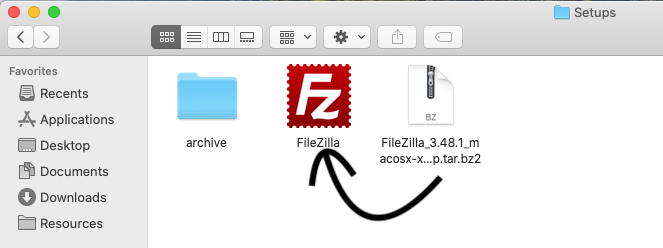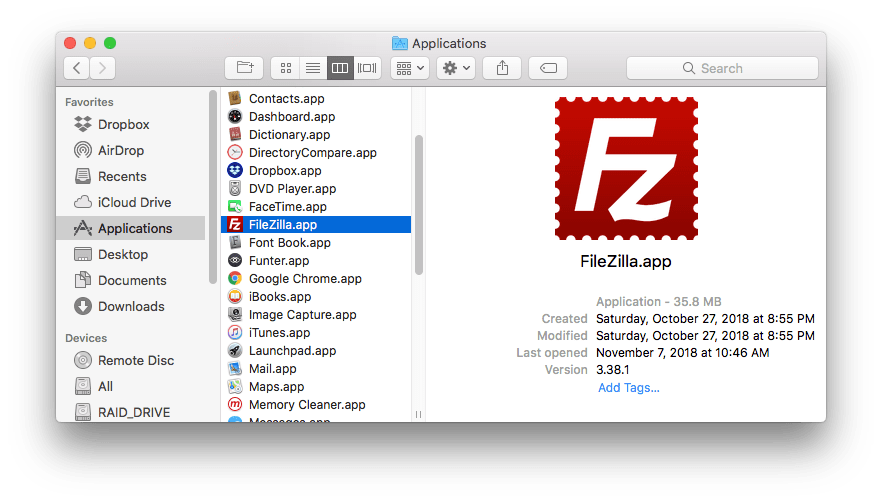

- #WHAT DIRECTORY TO INSTALL FILEZILLA ON MAC MAC OS#
- #WHAT DIRECTORY TO INSTALL FILEZILLA ON MAC UPDATE#
- #WHAT DIRECTORY TO INSTALL FILEZILLA ON MAC PRO#
- #WHAT DIRECTORY TO INSTALL FILEZILLA ON MAC DOWNLOAD#
#WHAT DIRECTORY TO INSTALL FILEZILLA ON MAC PRO#
The following distributions where FileZilla Pro does not work: The systems where FileZilla Pro is known to work are: Please note that due to differences in distributions, the provided binaries for Debian Linux might not work on different GNU/Linux systems. The shortcut will be in the list of available applications. In this case move the sktop to your applications directory: Note that some desktop environments do not support desktop icons. Make it available in the list of applications Mark Is Executable or Allow executing file as program.If you use another desktop environment, like KDE, you need to change the shortcut properties to allow execution:.You can then use the font management program to install the fonts on your system when you need them and uninstall them when you don’t, avoiding slowdowns. You can load all your fonts into a single program so you can preview and manage them in one place. If you need to use a very large number of fonts for some reason, you may want to use a font management program. Run the fc-cache command afterward to unregister the fonts from the system. local/share/fonts directory in your home folder instead. If you added the font with GNOME Font Viewer, browse to the. fonts folder in your home directory and delete the font files from there. Open a terminal and run the fc-cache command.
#WHAT DIRECTORY TO INSTALL FILEZILLA ON MAC UPDATE#
You will need to update your font cache before fonts you place in this folder are available in applications. Place font files in this directory to install them for your user account. If it doesn’t exist, right-click in your home directory, create a new folder, and name it. In Nautilus, click View > Show Hidden Files to view hidden folders. First, open your Home directory in a file manager. You can install fonts manually - or install multiple fonts at once - by placing them in your user account’s.

Click the Install button to install the font for your user account. On Ubuntu or any other GNOME-based Linux distribution, GNOME Font Viewer will appear. You can then double-click the font to preview it.
#WHAT DIRECTORY TO INSTALL FILEZILLA ON MAC DOWNLOAD#
To install a font, first download it in TrueType (.ttf), PostScript Type 1 (.pfb +. To install multiple font files at once, drag and drop them onto the Font Book window.ĭifferent Linux distributions come with different desktop environments, and those different desktop environments contain different applications for this. You can then re-enable it from the same menu later. To disable a font you’ve installed, right-click it and select Disable “Font Name” Family. To remove a font, right-click it and select Remove “Font Name” Family. To launch it from your keyboard, press Command + Space to open Spotlight search, type “Font Book,” and press Enter. You can also open Launchpad and click the Font Book shortcut. In the Applications folder, double-click on FileZilla to open it. Here’s a short explanation of each line: Protocol protocol for exchanging files over any network. Once the Site Manager window pops up, click New Site and fill in the columns with your FTP details. Move (drag) the app to the Applications folder. You can do so by going to the File menu or pressing CTRL+S ( CMD+S on macOS). This will extract the FileZilla app into the Downloads folder. Go to the Downloads folder and double click on the file FileZilla3.17.0.1macosx- 2. To open it, open the Finder, click Applications in the sidebar, and double-click Font Book. To download and install FileZilla: To Download, go to. You’ll find a list of installed fonts in the Font Book application. Click Install Font in the preview window to install it. Double-click the downloaded font file to preview it.
#WHAT DIRECTORY TO INSTALL FILEZILLA ON MAC MAC OS#
To install a font on Mac OS X, download it in OpenType (.otf), TrueType (.ttf), Datafork TrueType Suitcase (.dfont), or an older type of font file Macs supports, like PostScript Type 1. To install multiple fonts at once, drag and drop them into the Fonts window. Uninstall a font by right-clicking it and selecting Delete.

You can also press the Windows key once to open the Start menu or Start screen, type “Fonts” to search your system, and click the Fonts folder shortcut that appears.įrom here, you can preview your installed fonts. Open the Control Panel, click Appearance and Personalization, and click Fonts to access it. You’ll find a list of installed fonts in your Fonts folder.


 0 kommentar(er)
0 kommentar(er)
